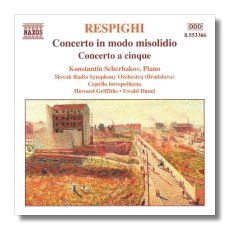
The Internet's Premier Classical Music Source
Related Links
- Respighi Reviews
- Latest Reviews
- More Reviews
-
By Composer
-
Collections
DVD & Blu-ray
Books
Concert Reviews
Articles/Interviews
Software
Audio
Search Amazon
Recommended Links
Site News
 CD Review
CD Review
Ottorino Respighi

Concertos
- Concerto in modo misolidio
- Concerto a cinque *
Konstantin Scherbakov, piano
* Igor Fábera, oboe
* Jurjaz Bartoš, trumpet
* Jarolin Ružička, violin
* Radoslav Šaslina, double bass
Slovak Radio Symphony (Bratislava)/Howard Griffiths
* Capella Istropolitana/Ewald Daniel
Naxos 8.553366 61:02
This discs was a pleasant surprise. In fact, it was a fascinating one. I was familiar with Respighi's other orchestral works such as the Roman Trilogies, Ancient Airs and Dances, etc. These works share some of the same notions as the popular ones, but they are also different in an absurdist sort of way.
Both works have some links with the composer's love of exploring older musical forms (most notably in the already mentioned Ancient Airs). The notes explain this connection, but I will tell you right now that these works are no Ancient Airs. No, this stuff is from a slightly different sound world.
I will start with the Concerto a cinque because I find it more interesting. From the very start, the music, for some reason, brings to my mind the opening movement of Roussel's Third Symphony. It is possible that Respighi heard that work, this one was composed just two years after Roussel's. What they share is the dance-like thumping, less pronounced in the first movement but especially stong in the opening of Cinque's last movement. In both the first and last, there is a trumpet punctuation at the end of phrases that adds a Chaplinesque oddity to proceedings. I also note jazz references and gypsy like violin licks in various places. Now, add to this that for some reason, as I listen to this music I envision adobe houses in a mid-day sun with dust devils swirling about. There is something, for some reason, that recalls music of north African locales. I just report what I feel, I don't attempt to explain it. Anyway, it is fascinating music that has a chamber-like quality to it. The small orchestra provides a continuo to matters. The second movement is more dreamy in atmosphere. At times I think it is music in search of a theme. The final movement returns to the nuttiness of the first. It's all a lot of fun.
The Concerto in modo is earlier. It dates from 1924 whereas the Cinque is from 8 years later. As I listened to these pieces, I began to wonder how they fit in with the scheme of some of his other compositions. I wondered this because at times it seemed like Respighi was exploring ideas in these two works that he developed differently in some of his more popular works like Ancient Airs and Dances, and the Roman Trilogies. So, here it goes: Fountains of Rome ('16) Ancient Airs I ('17) Ancient Airs II ('24) Pines of Rome ('24) Concerto Modo ('24) Roman Festivals ('28) Ancient Airs III ('32) and the Concerto Cinque also in '32. Deduce what you will.
The piano concerto (and that is what it is) doesn't have quite the same absurdist atmosphere, but it isn't normal Respighi a la the popular things. There are moments where I suddenly feel that the Magnificent Seven are about to ride onto the screen. At the same time there are weird moments, like at about 6:00 into the first movement. It sounds like the pianist is creating a thumping using the pedal. I have vague recollections about being able to do this on the piano. On the other hand, it may also be thumping timpani, which is what emerges from the passage. It's neat, whatever it is. Listening pays rewards over and over.
I had a friend once who told me that his wife refused to listen to Respighi. She was convinced that he was a film composer, not a classical one. If all you know are the popular pieces you might well agree. These works, however, offer another insight. That is: try it, you'll like it.
Copyright © 1999, Robert Stumpf II




















